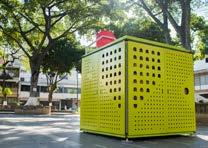
4 minute read
The Catalyst Cube: thinking outside the box
INTERNATIONAL SHOWCASE by Will Sandy
The Catalyst Cube, showcased in Caracas, Venezuela is an accessible and engaging green intervention for communities
The Catalyst Cube is a moveable, multifunctional pavilion that’s designed to be placed directly into the existing landscape to inspire social, cultural and educational exchanges. I designed it to connect people with their immediate environment, while its presence creates an instant neighbourhood focal point. Temporary interventions can play a key role in bringing nature into the city and connecting people with the public realm. With that in mind, from the very start, planting was an integral design aspect of the Catalyst Cube. Its green roof grounds the project in the landscape and local climate, enhancing the natural characteristics of its home city or district. Not only does its roof inject a shot of greenery into the neighbourhood where it’s placed, at the same time it creates a visual connection to the wider landscape – you start to notice what else is, or isn’t, there. Over the years, I’ve seen how changing the physical fabric of our urban environments with such green interventions can help people to view the city around them with fresh eyes. In the case of the Catalyst Cube – which made its debut in Caracas, Venezuela – the very planting of its roof became a tool to engage local children and families, while inspiring them to explore other existing green spaces. In this way, the Cube can encourage citizens to take an interest in more permanent streetscape design and green enclaves in our urban environments.

A local landmark.
© Edgar Martinez
In turn, its intrinsic flexibility allows it to support a diverse range of activities, from basketball games and exhibitions, to community events and neighbourhood meetings. It gives people the agency to define and curate public spaces for themselves at a time when cities’ physical and social fabrics are in constant flux. This is important because, in life, there are three places that humans identify with: the home, the workplace and the third place. The Cube sets out to be a third, and crucially green, place in the urban landscape.
The green roof of the Cube has also provided an opportunity to test the idea for the first temporary modular green roof. This has been developed through conversations and design development with the team at Green Roof Revival. We believe it is possible to provide an instant green roof solution for temporary buildings or installations. Whether the crown of the Cube or adorning the roofs of shipping container shops, leisure or work spaces, or the swathes of temporary welfare units and offices on building sites, it’s a temporary solution that offers the benefits of green roofs with none of the on-site disruption. It introduces an instant visual amenity and a vital verdant network that enhances routes across cites.

Flexible and adaptable façades.
© Edgar Martinez

Community planting events.
© Smiley Plant Organisation
This is key when we consider, for example, The City of London’s Open Space Strategy 1 . It outlines a series of strategic objectives, including the need to ‘effectively manage the temporary loss of any open space during construction projects and ensure that high quality open space of equivalent or greater size is established as soon as possible following the necessary works.’ Certainly, there is scope to introduce temporary green spaces that enrich the biodiversity of a city as it evolves and develops. Such interventions will also help to inspire, influence and inform the future permanent design of the built environment.
Like our proposed temporary green roof, the Cube is delivered to site whole or as a kit of parts, providing instant activation while minimising disruption. Now, I see potential for the Cube to be a moveable and reusable asset for local councils, developers and organisations to adopt and utilise across multiple locations.

Opportunities for knowledge sharing.
© Edgar Martinez
Back to its origins, however. The Catalyst Cube is born from Reframing Spaces Caracas, a project I undertook with the British Council in Venezuela, to explore ways to improve the quality of life for modern-day Caraqueños. The year-long programme of work was carried out with the British Council and local practice Incursiones Architects – with input from citizens, students and the creative design community of Caracas – addressing the daily social and cultural challenges faced by the citizens of this capital city. The resulting Cube is currently in situ, providing neighbourhoods with a sense of ownership and pride in their city, while promoting safer, responsible use of public space.
Such seemingly modest local initiatives, pocket parks, temporary activations and tactical urbanism aggregate up into a whole that makes a city not only more liveable and diverse, but are also critical contributors to the cities’ resilience. When we start to appreciate these moments of green, we begin to understand what works and how nature is reclaiming urban spaces. From here, we can enhance our city streets in the name of both nature and the betterment of human residents’ lives.
Will Sandy runs a multidisciplinary landscape architecture and design studio founded in 2009. Alongside his own studio, Will was co-founder and creative director at The Edible Bus Stop.










